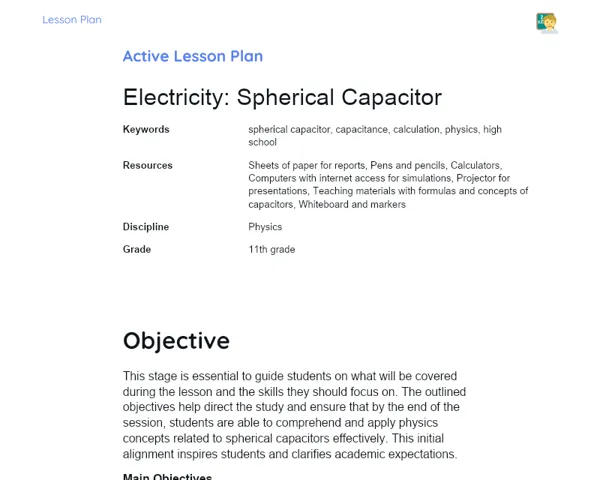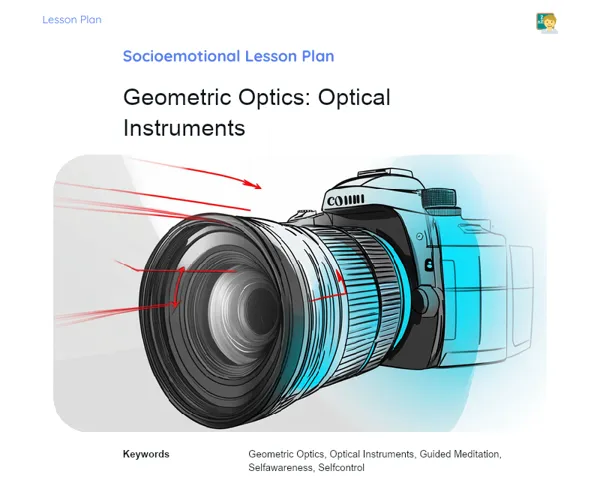Lesson Plan | Lesson Plan Tradisional | Lens: Lens Maker's Equation
| Keywords | Lens Maker's Equation, Focal Length, Refractive Index, Radii of Curvature, Biconvex Lenses, Plano-Convex Lenses, Optical Physics, Problem Solving, Practical Applications, Optical Engineering |
| Resources | Whiteboard, Markers, Projector or digital board, Presentation slides, Calculators, Notebooks or sheets for notes, Printed problem examples, Pencils and erasers |
Objectives
Duration: 10 to 15 minutes
The aim of this stage is to ensure that students have a clear grasp of the essential concepts related to the lens maker's equation and are capable of applying them in practical calculations. This foundational understanding will support effective problem-solving and comprehension of optical phenomena, making subsequent stages of the lesson easier to follow.
Objectives Utama:
1. Introduce the lens maker's equation, clarifying each term and its units.
2. Show how to apply the equation to compute radii of curvature, focal lengths, and indices of refraction in various practical scenarios.
Introduction
Duration: 10 to 15 minutes
The objective at this stage is to ensure students understand the key principles of the lens maker's equation and can apply these principles in practical situations. This will serve as a strong base for solving problems and comprehending optical phenomena, which is crucial for the learning to follow.
Did you know?
Did you know that corrective lenses, much like those in glasses, were developed over 700 years ago? The advancement in lens design has significantly revolutionized fields like astronomy, enabling us to observe distant celestial bodies in remarkable detail.
Contextualization
To kick off the lesson, discuss with students that lenses are key optical components in many devices we encounter daily, such as spectacles, cameras, microscopes, and telescopes. Grasping how lenses operate and the factors influencing their properties has practical implications across various fields, ranging from correcting vision to exploring outer space. Today’s focus will be on the lens maker's equation, an essential mathematical tool used for describing and designing lenses.
Concepts
Duration: 50 to 60 minutes
The intent at this stage is to thoroughly discuss the lens maker's equation and its uses, ensuring that students comprehend each term of the equation and its application in solving real problems. This depth of understanding is vital for applying theoretical concepts in practical scenarios and developing critical analytical skills pertinent to optical physics.
Relevant Topics
1. Introduction to the Lens Maker's Equation: Explain that the lens maker's equation links the geometrical properties of the lens to the refractive index of the lens material. The equation can be stated as: 1/f = (n - 1) * (1/R1 - 1/R2), where f represents the focal length of the lens, n is the refractive index of the lens material, and R1 and R2 denote the radii of curvature for the lens surfaces.
2. Terms of the Equation: Provide a clear explanation of each term in the equation. Clarify that f is the focal length, which can be positive for converging lenses and negative for diverging lenses. n is the refractive index corresponding to the lens material, varying by type (for instance, glass or plastic). R1 is positive when the surface faces incoming light and negative when facing outgoing light; R2 always takes the opposite sign of R1.
3. Application of the Equation: Demonstrate how to practically apply the equation to solve problems. Share explicit examples such as determining the focal length of a lens when the radii of curvature and the refractive index are known. For instance: A biconvex lens has curvature radii of R1 = 10 cm and R2 = -15 cm, with a glass refractive index of n = 1.5. Calculate the focal length f.
To Reinforce Learning
1. A biconvex lens has curvature radii of R1 = 20 cm and R2 = -25 cm, and is made from a material with a refractive index of n = 1.6. Determine the focal length of the lens.
2. A plano-convex lens has a radius of curvature of R1 = 30 cm and consists of plastic with a refractive index of n = 1.5. The opposite surface of the lens is flat (R2 = ∞). Calculate the focal length of the lens.
3. Find the refractive index of a material for a biconvex lens with radius curvatures of R1 = 18 cm and R2 = -18 cm, given that the lens has a focal length of f = 12 cm.
Feedback
Duration: 20 to 25 minutes
The aim of this stage is to revisit and solidify students' understanding of how to use the lens maker's equation, ensuring they comprehend every aspect of the problem-solving process. This feedback moment allows for addressing any questions, reinforcing learned concepts, and promoting critical thinking and dialogue in the classroom.
Diskusi Concepts
1. Question 1: A biconvex lens has curvature radii of R1 = 20 cm and R2 = -25 cm and is made from material with a refractive index of n = 1.6. Calculate the focal length of the lens.
Explanation:
The lens maker's equation can be expressed as: 1/f = (n - 1) * (1/R1 - 1/R2).
Substituting the values given:
1/f = (1.6 - 1) * (1/20 - 1/(-25))
1/f = 0.6 * (1/20 + 1/25)
1/f = 0.6 * (0.05 + 0.04)
1/f = 0.6 * 0.09
1/f = 0.054
So, the focal length of the lens is approximately 18.52 cm.
2. Question 2: A plano-convex lens has a radius of curvature of R1 = 30 cm and is constructed from plastic with a refractive index of n = 1.5. The other surface of the lens is flat (R2 = ∞). Calculate the focal length of the lens.
Explanation:
The lens maker's equation can be stated as: 1/f = (n - 1) * (1/R1 - 1/R2).
For a flat surface, R2 = ∞, hence 1/R2 = 0.
Substituting the provided values:
1/f = (1.5 - 1) * (1/30 - 0)
1/f = 0.5 * (1/30)
1/f = 0.5 * 0.0333
1/f = 0.0167
Thus, the focal length of the lens is approximately 60 cm.
3. Question 3: Determine the refractive index of a material for a biconvex lens with curvature radii of R1 = 18 cm and R2 = -18 cm, knowing that the lens has a focal length of f = 12 cm.
Explanation:
The lens maker's equation is given by: 1/f = (n - 1) * (1/R1 - 1/R2).
By substituting the values:
1/12 = (n - 1) * (1/18 - 1/(-18))
1/12 = (n - 1) * (1/18 + 1/18)
1/12 = (n - 1) * (2/18)
1/12 = (n - 1) * (1/9)
(n - 1) = 12/9
(n - 1) = 1.333
Thus, the refractive index of the lens material is 2.333.
Engaging Students
1. ❓ Question: In what ways can the lens maker's equation be applied to different lens types, such as diverging lenses? 2. 🔍 Reflection: Encourage students to consider how variations in the radii of curvature impact the focal length of the lens. 3. 📏 Question: What are some practical uses of the lens maker's equation in the fields of engineering and medicine? 4. 💡 Reflection: Initiate a discussion on how differences in the refractive indices of materials can affect lens design in various technological gadgets.
Conclusion
Duration: 10 to 15 minutes
The goal of this stage is to synthesize the main ideas covered during the lesson, reinforce the connection between theory and its practical implementation, and emphasize the relevance of the topic in students' lives. This closing moment is designed to solidify the learning, resolve any outstanding queries, and inspire students to utilize their newfound knowledge in real-world applications.
Summary
["Introduction to the lens maker's equation, covering its mathematical expression: 1/f = (n - 1) * (1/R1 - 1/R2).", "Detailed explanation of the equation's terms: focal length (f), refractive index (n), and radii of curvature (R1 and R2).", 'Demonstration of how to use the equation for solving practical problems, such as computing radii of curvature, focal lengths, and refractive indices across diverse lens types.', 'Guided resolution of practical cases, including biconvex and plano-convex lenses, as well as how to ascertain the refractive index of the lens material.']
Connection
The lesson effectively bridged theory with practice by demonstrating the practical application of the lens maker's equation to real-world problems. Step-by-step resolutions allowed students to see how theoretical knowledge is leveraged to calculate lens properties in devices commonly used in daily life and technology.
Theme Relevance
Understanding the lens maker's equation is vital for designing and applying optical technologies that permeate our everyday experiences. From spectacles that enhance vision to sophisticated tools like cameras, microscopes, and telescopes, mastery of this equation is essential for the development of devices that enrich our lives and expand our capacity to observe and understand our environment.



